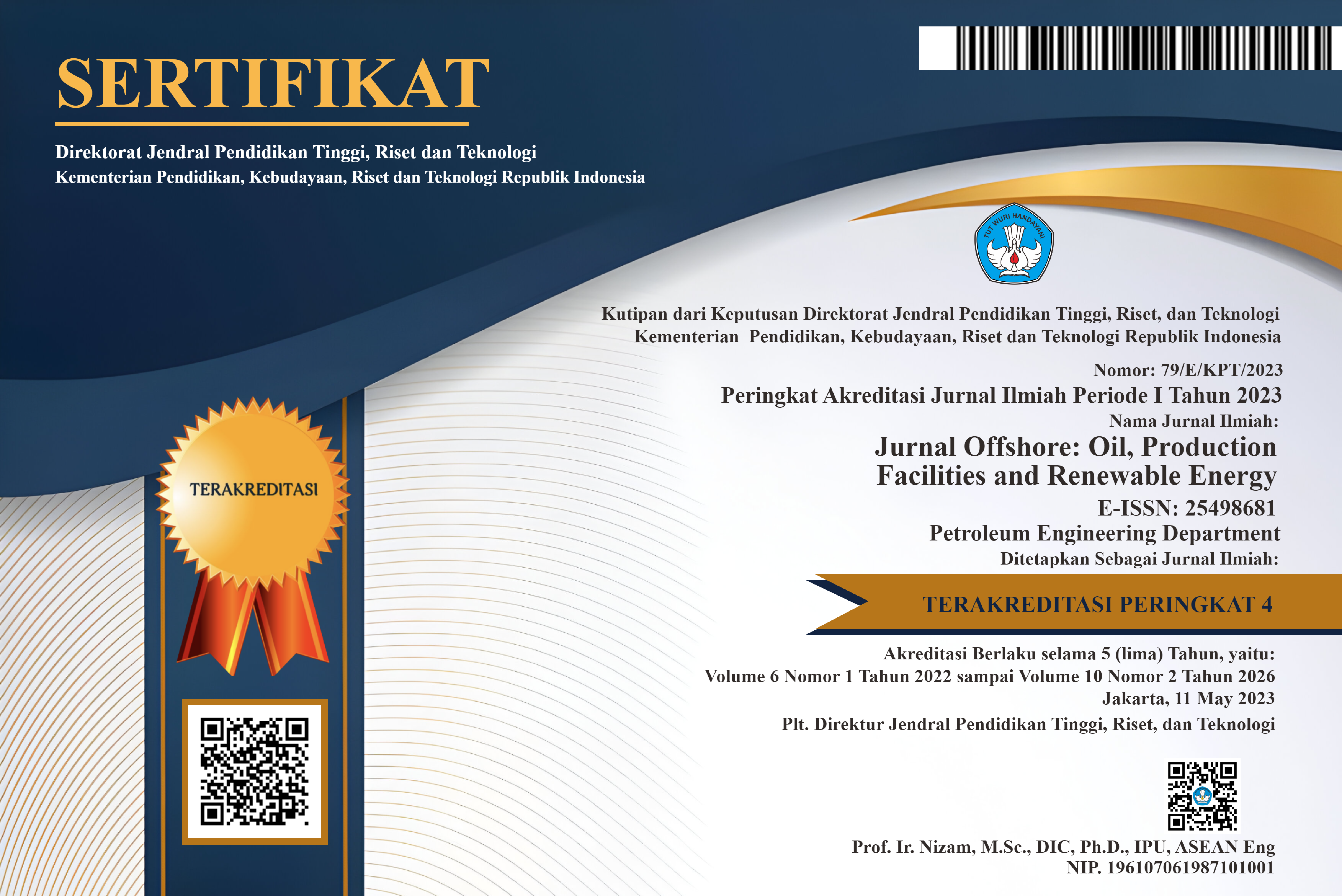Perencanaan Ulang Sucker Rod Pump pada Sumur “X” Lapangan “Y”
DOI:
https://doi.org/10.30588/jo.v2i1.359Keywords:
artificial lift, sucker rod pump, target produksi, production targetAbstract
Tujuan dari penelitian ini untuk menentukan metode yang cocok digunakan untuk suatu sumur produksi, dan salah satu metode yang dipakai adalah pengangkatan buatan dengan pompa, yaitu Sucker Rod Pump (SRP). Metode pemakaian Pompa Angguk atau Sucker Rod Pump (SRP) digunakan apabila suatu sumur minyak sudah tidak dapat lagi mengangkat fluida dari dasar sumur ke atas permukaan secara sembur alam, atau dengan menggunakan metoda yang lain misalnya gas lift tidak memenuhi persyaratan. Sucker rod pump merupakan salah satu metoda pengangkatan buatan, dimana untuk mengangkat minyak kepermukaan digunakan pompa untuk mengangkat minyak kepermukaan digunakan pompa dengan rangkai roda (rod). Pompa ini digunakan untuk sumur-sumur dengan viskositas rendah-medium, tidak ada problem kepasiran, GOR tinggi, sumur-sumur lurus dan fluid level tinggi. Prinsip kerja sucker rod merupakan perpaduan gerak antara peralatan di permukaan dan dibawah permukaan. Dan hasil akhir yang diharapkan dengan menggunakan metode artficial lift ini adalah untuk memaksimalkan produksi sehingga dapat memenuhi target produksi yang telah ditentukan.
The purpose of this research is to determine the suitable method used for a production well, and one of the methods used is artificial lifting with a pump, namely Sucker Rod Pump (SRP). The method of using a Sucker Rod Pump (SRP) is used if an oil well is no longer able to lift fluid from the bottom of the well to the surface by natural spray, or by using other methods such as a gas lift that does not meet the requirements. Sucker rod pump is one of the artificial lifting methods, where to lift the oil to the surface a pump is used to lift the oil to the surface using a pump with a rod chain. This pump is used for wells with low-medium viscosity, no sand problems, high GOR, straight wells and high fluid levels. The working principle of a sucker rod is a combination of motion between equipment on the surface and below the surface. And the expected end result using the artficial lift method is to maximize production so that it can meet predetermined production targets.
References
Amyx, J.W., D.M.Jr., Whitting, R.L.1960 .“Petroleum Reservoir Engineering Physical Properties”, Mc. Graw Hill Book company, New York USA- Toronto, Canada – London England
Brown, K. E. 1980. The Technology of Artificial Lift Methods, vol. 2A, Pen Well Publ.,
Craft, B. C., Holden, W. R. & Graves, E. D. Jr. 1962. Well Design Drilling and Production“ Prentice Hall.
Nind,T.E.W,. 1981. Principles of Oil Well Production, McGraw Hill.
Patton, C, C. 1981. Oilfield Water System, Campbell Petroleum Seies, Norman, Oklahoma,.
Pettyjohn, F. J,. 1957 .Sedimentary Rock, Harper and Brother, New York.
Pudjo Sukarno, DR, Ir,.1990. Production Optimization with Nodal System Analysis. PT Indrillo, Sakti, Jakarta.
Purwaka, E. St, 2012. Hand Out Kuliah Sucker Rod Pump, Universitas Proklamasi 45 Yogyakarta.
Downloads
Published
How to Cite
Issue
Section
License
Authors retain copyright and grant the Jurnal Offshore right of first publication with the work simultaneously licensed under a Creative Commons Attribution 4.0 International License that allows others to share (copy and redistribute the material in any medium or format) and adapt (remix, transform, and build upon the material) the work for any purpose, even commercially with an acknowledgement of the work's authorship and initial publication in Jurnal Offshore. Authors are able to enter into separate, additional contractual arrangements for the non-exclusive distribution of the journal's published version of the work (e.g., post it to an institutional repository or publish it in a book), with an acknowledgement of its initial publication in Jurnal Offshore. Authors are permitted and encouraged to post their work online (e.g., in institutional repositories or on their website) prior to and during the submission process, as it can lead to productive exchanges, as well as earlier and greater citation of published work (See The Effect of Open Access).















